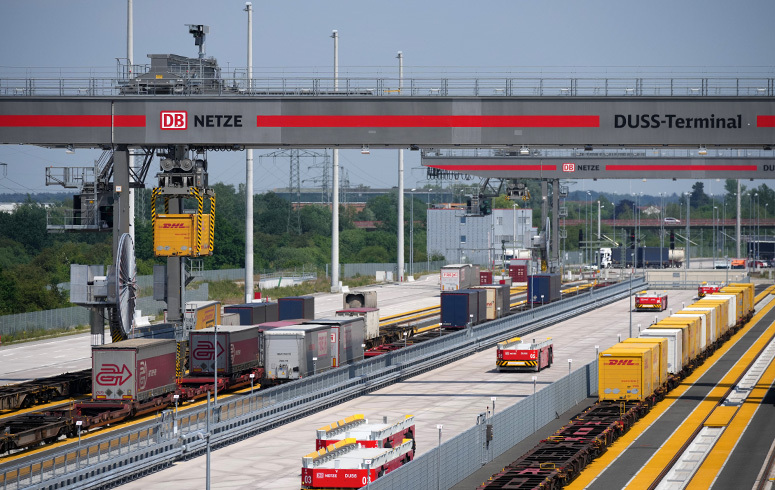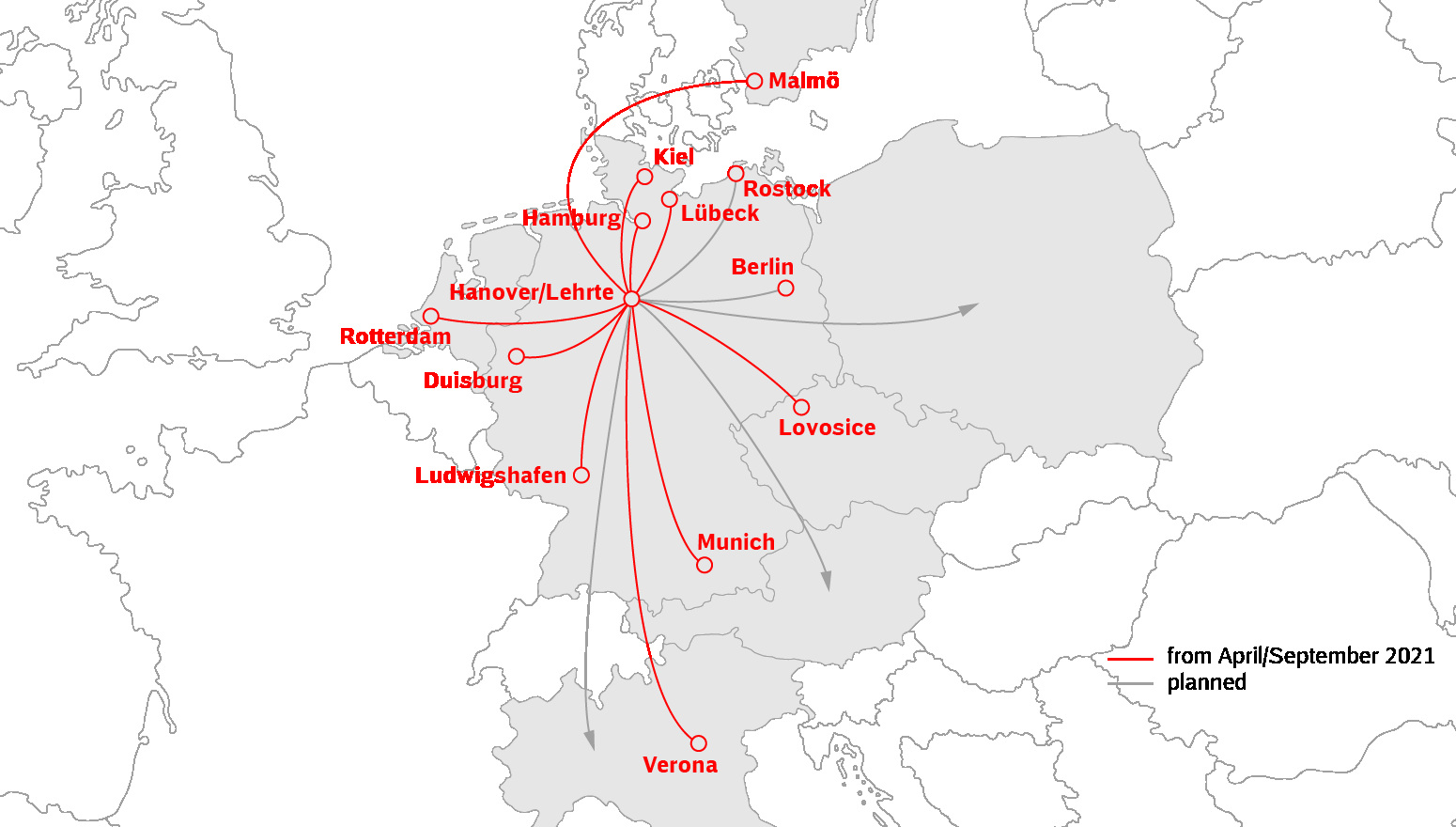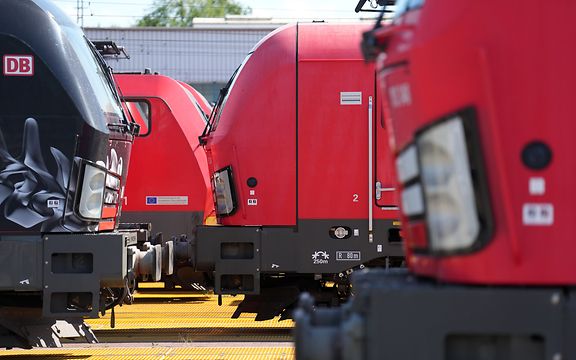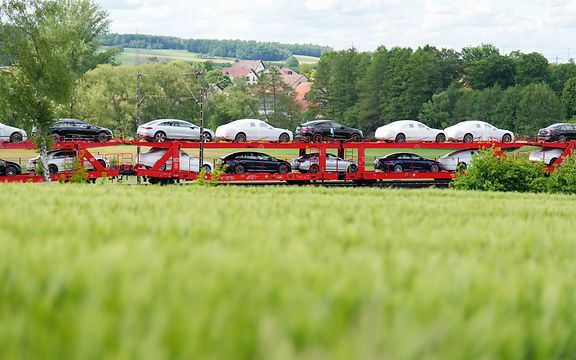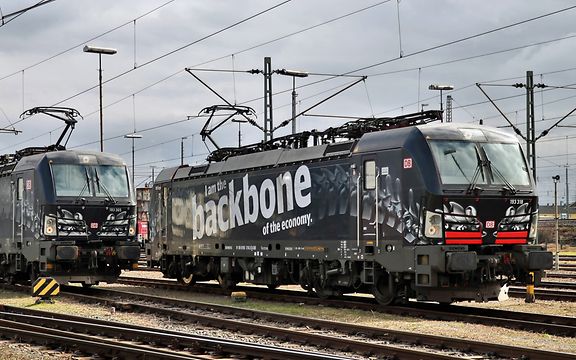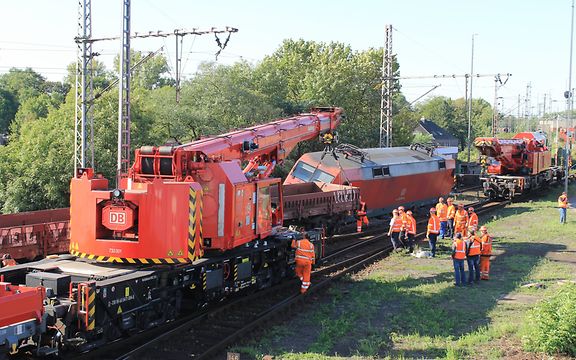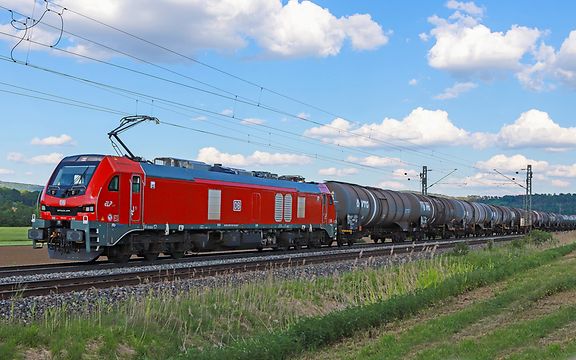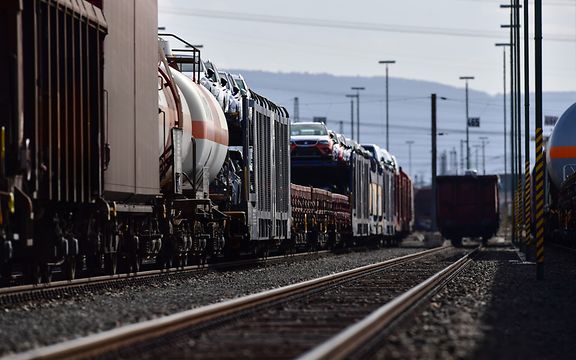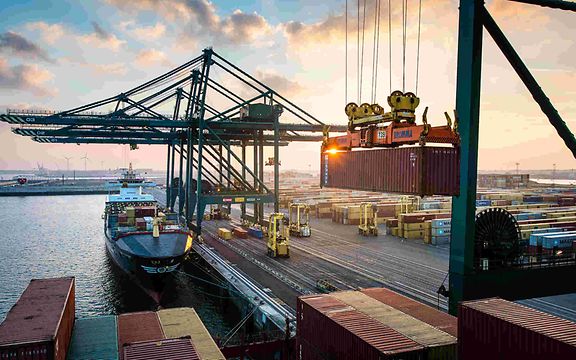MegaHub Lehrte: Now officially in business
The rapid transhipment facility is becoming a key network hub
Lübeck, Duisburg, Ludwigshafen, Munich and Verona are the destinations served by the intermodal transport specialist Kombiverkehr and DB Cargo in the first stage of their MegaHub Lehrte project. The facility acts as a central distribution base, enabling the freight companies to link all these terminals together. Connections have been designed so that trains arrive between 8:00 pm and 6:00 am with minimal idle time.
14 December 2021: New connections to Scandinavia and the Baltic states
The timetable change has brought new services connecting the terminals at Rotterdam Europoort and Lovosice to northern Europe and the Baltic states via Germany's ports of Kiel and Lübeck. Southbound connections with A/C schedules are also available from Rotterdam and Lovosice to Verona Interterminal in northern Italy. The new links from Rotterdam Europoort and Lovosice to Hanover-Lehrte will run four times a week in each direction on both routes.
Since mid-November, more connections have been available to and from Sweden, Norway, Finland and the Baltic states. They use the Baltic Rail Gate Terminal at Lübeck's Skandinavienkai dock. Three services a week link now this base to the fast transhipment facility in Hanover and vice versa. Customers can continue to use the Dänischburg CTL terminal in Lübeck for booking trailer, tank container and swap body transfers to the direct trains bound for Stockholm and Hallsberg within our northern European combined transport system. In addition, ferry links operate from this terminal to St Petersburg and Finland.
14 September 2021: New intermodal connection
Direct trains are now operating between the terminals at Munich-Riem and Wels CTT. There are three departures in each direction every week. The cut-off time for accepting containers, tank containers and swap bodies in Munich is 19:50 on Monday, Wednesday and Friday. In Wels, the cut-off time for services bound in the opposite direction is 17:45 on Tuesday and Thursday, and 15:00 on Saturday. The trains operate as overnight services, meaning that load units can be collected early in the morning for delivery to customers. Compared to a connection that uses road transport only, moving freight by train cuts CO2e emissions by 280 kg for every 25 tonnes of load. This corresponds to a 75% reduction in emissions.
3 August 2021: New connections
Work is now underway on the first expansion stage, which entails a host of new services for freight forwarders and logistics companies. Ever since 3 August 2021, for example, customers have had the option of using three weekly departures to move intermodal loading units to the combined transport terminal operated by Mertz in Malmö, Sweden, via Lehrte's MegaHub. As of 6 September, we will add an extra departure to bring our schedule up to four services a week. On the same day, we will also add Hamburg-Billwerder and the Port of Kiel to our ground-breaking national and international transport network for the first time. There will be five weekly services on each of these routes, and the Kiel connection will call at the Schwedenkai and Ostuferhafen.
The MegaHub blueprint for logistics projects
After several months of scheduled operations, it is time to take a look at what the future holds. Ulrich Bedacht, head of Kombiverkehr's northern Europe and German Baltic port business, is certain of one thing: "There is no doubt that the MegaHub is a flagship project for other sites that currently lack terminals of their own to connect the region. You could call it a logistics blueprint for all of Germany." Dieter Brinckmann, Key Account Management Kombiverkehr Carrier Sales Intermodal, knows what he wants to achieve with the MegaHub's capabilities in the two years before he retires: "We will coordinate with Kombiverkehr to successively increase the number of trains. At the same time, we will keep a close eye on customers' requirements, their service needs and the associated cargo flows. We will also increase MegaHub's European focus still further, by means of connections linking east and west, north and south."
The big advantage of the Lehrte hub is the way that trains enter the facility at one end and exit at the other. Terminals, as the word suggests, are traditionally designed as a terminus where the way in is also the way out. Things are different at Lehrte: trains arrive and depart without switching direction or locomotive, so speed is the site's trump card. Whereas at conventional terminal gateways, it is not uncommon for a consignment's journey to be interrupted for up to 12 hours, at Lehrte most cargo can "change trains" in less than three hours, cutting two-thirds off the time required for transhipment. “Our MegaHub is so successful because we have managed to perfect the complex management of timetables, traction, train paths and terminals to the point that trains arrive at the best possible time and never need to wait. This is a real challenge," Brinckmann says.
Ostermann: Short trips for pre- and onward carriage
Moritz Ostermann, managing director at Ostermann Transporte GmbH, confirms the MegaHub's benefits. "My company has specialised in transporting liquid loads around Europe for decades, and we started using intermodal traffic a number of years ago," he says. "We have added transports via the MegaHub near Hanover in the past few months. This has been doubly beneficial. We now have short pre- and onward carriage runs between Lehrte and our loading points in the region southwest of Hanover. Plus, we have access to fast hub services for our long-distance international traffic to Austria and Italy."
Ostermann has followed the site's development closely from the very start: "Communication is getting better all the time. The facility has well-rehearsed throughput times and convenient opening hours. We hope that more terminals will be connected to Lehrte in the coming months." With Lehrte having concentrated on making speed its hallmark when merging consignments arriving from different directions, Ostermann believes its goal should always be to set new standards for the rapid handling of incoming and outbound units and accelerate processes even further. "We're happy users of the facility and Kombiverkehr's new intermodal services, and we're really looking forward to the hub's growth and development," he says.
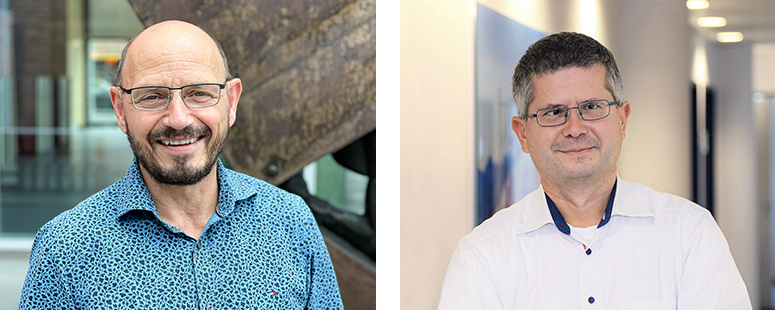
From Lehrte to destinations across Europe
The idea behind Lehrte was to create a fast transhipment facility using cranes to individually tranship incoming containers, semi-trailers and swap bodies, sorting consignments onto freight trains by destination. Like all good ideas, it took a while for this one to come to fruition. There had long been plans to select a site just outside Hanover as a central hub for rapid transhipment. Dieter Brinckmann's enthusiasm for this large-scale project is obvious as he recalls its origins: "Back then, combined transport had really taken off and we realised that we needed to do more. This was the start of a fascinating undertaking that I'm lucky to be part of."
Ulrich Bedacht has been at Kombiverkehr for 30 years. "It's fun to see a project like this working out and hitting its stride," he says. "Especially because, looking back, it wasn't always clear that it would succeed. It did in the end, because so many people pulled together."
